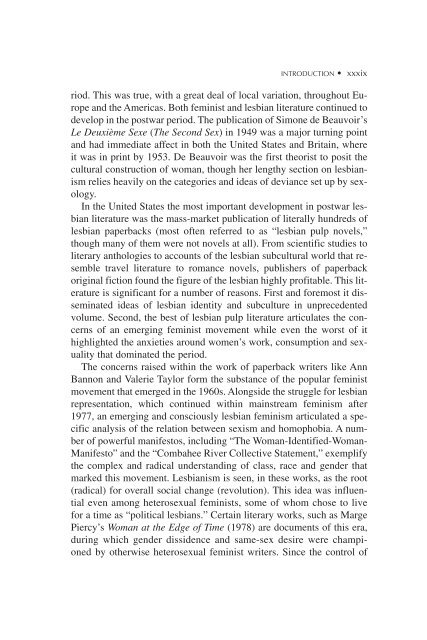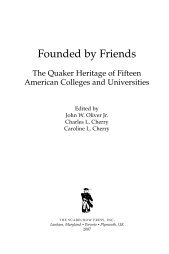Historical Dictionary of Lesbian Literature - Scarecrow Press
Historical Dictionary of Lesbian Literature - Scarecrow Press
Historical Dictionary of Lesbian Literature - Scarecrow Press
You also want an ePaper? Increase the reach of your titles
YUMPU automatically turns print PDFs into web optimized ePapers that Google loves.
INTRODUCTION • xxxix<br />
riod. This was true, with a great deal <strong>of</strong> local variation, throughout Europe<br />
and the Americas. Both feminist and lesbian literature continued to<br />
develop in the postwar period. The publication <strong>of</strong> Simone de Beauvoir’s<br />
Le Deuxième Sexe (The Second Sex) in 1949 was a major turning point<br />
and had immediate affect in both the United States and Britain, where<br />
it was in print by 1953. De Beauvoir was the first theorist to posit the<br />
cultural construction <strong>of</strong> woman, though her lengthy section on lesbianism<br />
relies heavily on the categories and ideas <strong>of</strong> deviance set up by sexology.<br />
In the United States the most important development in postwar lesbian<br />
literature was the mass-market publication <strong>of</strong> literally hundreds <strong>of</strong><br />
lesbian paperbacks (most <strong>of</strong>ten referred to as “lesbian pulp novels,”<br />
though many <strong>of</strong> them were not novels at all). From scientific studies to<br />
literary anthologies to accounts <strong>of</strong> the lesbian subcultural world that resemble<br />
travel literature to romance novels, publishers <strong>of</strong> paperback<br />
original fiction found the figure <strong>of</strong> the lesbian highly pr<strong>of</strong>itable. This literature<br />
is significant for a number <strong>of</strong> reasons. First and foremost it disseminated<br />
ideas <strong>of</strong> lesbian identity and subculture in unprecedented<br />
volume. Second, the best <strong>of</strong> lesbian pulp literature articulates the concerns<br />
<strong>of</strong> an emerging feminist movement while even the worst <strong>of</strong> it<br />
highlighted the anxieties around women’s work, consumption and sexuality<br />
that dominated the period.<br />
The concerns raised within the work <strong>of</strong> paperback writers like Ann<br />
Bannon and Valerie Taylor form the substance <strong>of</strong> the popular feminist<br />
movement that emerged in the 1960s. Alongside the struggle for lesbian<br />
representation, which continued within mainstream feminism after<br />
1977, an emerging and consciously lesbian feminism articulated a specific<br />
analysis <strong>of</strong> the relation between sexism and homophobia. A number<br />
<strong>of</strong> powerful manifestos, including “The Woman-Identified-Woman-<br />
Manifesto” and the “Combahee River Collective Statement,” exemplify<br />
the complex and radical understanding <strong>of</strong> class, race and gender that<br />
marked this movement. <strong>Lesbian</strong>ism is seen, in these works, as the root<br />
(radical) for overall social change (revolution). This idea was influential<br />
even among heterosexual feminists, some <strong>of</strong> whom chose to live<br />
for a time as “political lesbians.” Certain literary works, such as Marge<br />
Piercy’s Woman at the Edge <strong>of</strong> Time (1978) are documents <strong>of</strong> this era,<br />
during which gender dissidence and same-sex desire were championed<br />
by otherwise heterosexual feminist writers. Since the control <strong>of</strong>
















